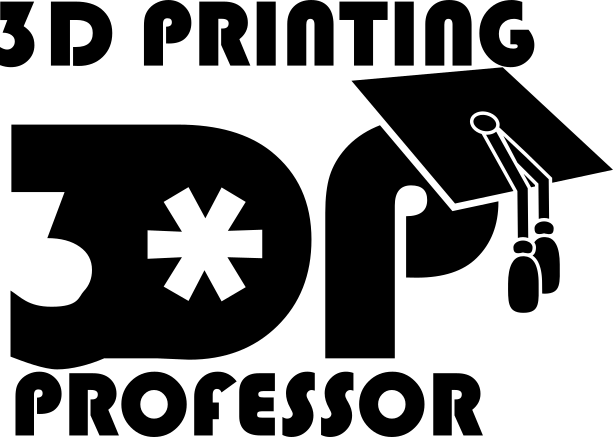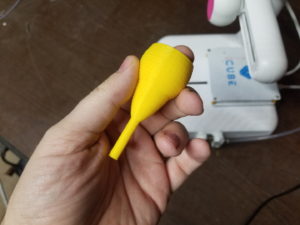GooFoo, you are on the cusp of greatness. You are teetering on the edge of something amazing here. And with the slightest bit of effort you’ll be able to provide the world what it wants and needs. And if you don’t, you may only have provided the blueprint for someone else to do it better.
I’m worried that if certain things remain unsaid, the wrong conclusions might be drawn from the experience of the Cube 3D printer.
The short version is: The Cube isn’t a total mistake. And it promises what people want. Curate your app, fix the wiggle in the “lego-like” connectors, do some QA before sending printers out, and keep the price low, and you could be there.
Long version:
They say you never get a second chance at a first impression. And for many people buying this, this was their first impression of 3D printing. What impression did you think it made? Well, after everything I went though, I think it told them “this isn’t for you if you’re not willing to do the work”. Many people thought this was their “in” to 3D printing, and now they’re out. And I feel that loss. And I think you do too. So I don’t want to be condemning or point the finger of scorn at you. I simply want to share my experience, and where it fell short, so that maybe there’s hope for those who want to get into 3D printing, but haven’t yet because it’s seemed too technically challenging.
When I first saw the Cube on IndieGoGo, I used it as an example for others to be able to analyze and critique future 3D printer campaigns. As it stands now, I could still criticize the campaign for being a little too marketing driven: Surrounding the 3D printer with prints that clearly didn’t come from this 3D printer, trying to sell a significantly marked up sample pack of filament as a add-on good deal, promising a delivery date that made people think they’d get this by Christmas when that wasn’t your intent. But, I can let go of those things. I can see through marketing ploys, and when I looked at this machine critically I saw that there was real possibility in.
In fact, I thought this might be the 3D printer that 3D printing needs right now.
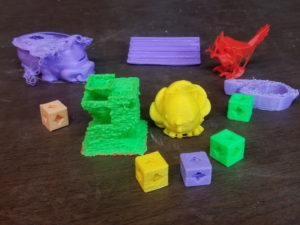 Let me explain what I mean by that. 3D printing right now is a hobbyist tool for making things. It’s uses industrial CNC technology, and brings it to a scale and scope, and price that puts it on track towards the consumer market. But it never quite makes it to the consumer level, ending up in the, I guess, “personal shop” level. It still requires a lot of technical confidence, but it’s affordable and accessible, and if you’re willing to do the fiddling, functional. And it’s found its audience in that space.
Let me explain what I mean by that. 3D printing right now is a hobbyist tool for making things. It’s uses industrial CNC technology, and brings it to a scale and scope, and price that puts it on track towards the consumer market. But it never quite makes it to the consumer level, ending up in the, I guess, “personal shop” level. It still requires a lot of technical confidence, but it’s affordable and accessible, and if you’re willing to do the fiddling, functional. And it’s found its audience in that space.
But there are still some people who see this technology and want to be a part of it. Some leap across the technical divide, and some of them actually make it. But those people are relatively few and far between. There’s a vast new audience on the other side of that technical divide that would adopt this technology into their homes if they could. But it would reqire a 3D printer that was:
- Affordable
- Worked out of the box
- Doesn’t require technical tools
- Doesn’t require technical software (like a slicer) to use
- Made what they wanted and needed.
And I think you know this. The GooFoo goes together with no tools. It prints without a slicer, just an app on your phone. There’s gCode, but it’s barely noticeable. And the price is more affordable. And that’s great. I think you got some of that crowd who wants a 3D printer that they don’t need technical confidence to use. But as this printer, as I received it, didn’t deliver on those promises.
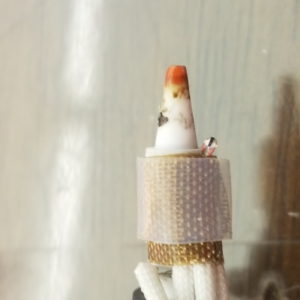 The Cube I received from this campaign was broken on many levels, some of which were really poor oversights of QA and could have damaged my machine, if not starting a fire in my house. The temperature sensor on the hot head was not where it needed to be, hanging out and only catching the ambient temperature around the nozzle. As a reusult it severely overheated the nozzle, vaporizing the material that the nozzle was made of, resulting in it outgassing something that gave me a headache until I discovered and fixed this.
The Cube I received from this campaign was broken on many levels, some of which were really poor oversights of QA and could have damaged my machine, if not starting a fire in my house. The temperature sensor on the hot head was not where it needed to be, hanging out and only catching the ambient temperature around the nozzle. As a reusult it severely overheated the nozzle, vaporizing the material that the nozzle was made of, resulting in it outgassing something that gave me a headache until I discovered and fixed this.
But that wasn’t the only problem this machine had. In getting it to a running state, there is not a single part of this machine that I have not taken apart and put back together. In doing so I discovered that this is not a machine designed to be taken apart and put back together. Screws going into plastic are not meant for easy maintenance. I needed a multimeter to fix an issue with the current going to the extruder motor. When I disassembled the Z-Axis to grease the rods, I discovered the rods were already greased, so either there wasn’t enough grease on them, or the silicone cover on the Z-Axis was introducing just enough friction to impede the movement.
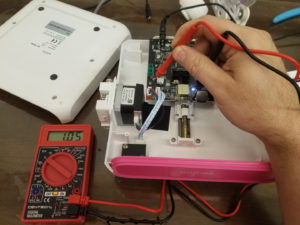 Your support team is to be publicly commended. They are doing their best to help people repair the problems they’re having with this machine, they are sending out new parts to people, I myself have received a new extruder head and X-Axis, and I appreciate this. You’re putting time and effort into seeing this printer be successful, so clearly you want this to succeed.
Your support team is to be publicly commended. They are doing their best to help people repair the problems they’re having with this machine, they are sending out new parts to people, I myself have received a new extruder head and X-Axis, and I appreciate this. You’re putting time and effort into seeing this printer be successful, so clearly you want this to succeed.
But if you put a little more effort into sending out printers that weren’t broken in the first place, you wouldn’t need to ship parts at your expense afterwards.
However, even after fixing every problem and replacing the hot end, there are problems that your support team isn’t going to be enough to address.
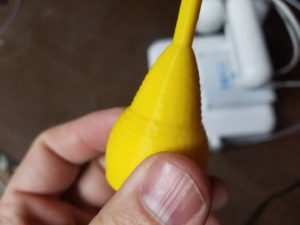 First of all, there’s the wiggle in the Z-Axis and X-Axis. Your lego-like assembly results in movement axis’s that are not stable. Even after getting this printer working with new parts, straight walls were wiggly. I don’t know what it will take to make this work while still providing a tool-free assembly. But as-is, the print quality is suffering so badly from the way this was engineered, that it may require going back to the drawing board somewhat.
First of all, there’s the wiggle in the Z-Axis and X-Axis. Your lego-like assembly results in movement axis’s that are not stable. Even after getting this printer working with new parts, straight walls were wiggly. I don’t know what it will take to make this work while still providing a tool-free assembly. But as-is, the print quality is suffering so badly from the way this was engineered, that it may require going back to the drawing board somewhat.
And then there’s the app.
I can not emphasize how important the app is to the experience this printer needs in order to appeal to that audience of non-technical people who want to get into 3D printing. It needs to be easy to use, a few hiccups in the setup process are acceptable, but once it’s up and running it needs to be an endless stream of fun and useful prints.
 What the app is, right now, is a mess of models ripped from thingiverse, scaled and sliced (I assume) by a script, that results in prints that either don’t make any sense, or are actually non-functional.
What the app is, right now, is a mess of models ripped from thingiverse, scaled and sliced (I assume) by a script, that results in prints that either don’t make any sense, or are actually non-functional.
So far from the app I’ve printed 3 things. A dice tower that was too small to roll dice down, a spice rack that was too small to put spices into, and a self watering bulb for planters that needed to be printed in vase mode, but was sliced as a solid object.
By populating your app this way, without thought or regard to how it will be used by people, you’re creating a situation where your app isn’t useful.
While I appreciate that this printer can be run headless, that’s for people with the technical confidence to run a 3D printer that way. And those people already have Creality and Prusa. They don’t need this bargain basement option with it’s wiggly frame, tiny build volume, noisy, limited material options, and really lousy spool holder.
There’s nearly 1000 people who took a risk on this machine. That’s nearly 1000 people who wanted what this 3D printer promised enough to take a chance on it. How many more people are there who would take the plunge if there weren’t so much risk? The audience is there, and some day someone is going to get the right combination of technology and packaging and the world will beat a path to their door. You were so close, GooFoo. And maybe in being so close, where it didn’t quite make it stands out all the more. I hope you don’t give up. I hope you don’t think that this means that there’s no audience for this. I see your efforts. I see where you’re trying to go, and I want you to succeed.
Good luck.
